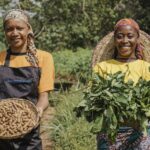The Sustainable Coconut Roundtable in Manila crackled with urgency this September. Industry leaders, government officials, and smallholder representatives filled the room. They shared one recognition: the coconut sector stands at a crossroads.
For Ksapa, this annual congress proved invaluable. We engage at the intersection of sustainability strategy and supply chain transformation. The event let us discuss the industry’s most pressing question. How do we rejuvenate this sector before it’s too late?
Conversations throughout reinforced what our agricultural work consistently shows. The challenges are systemic. The stakes are high. But solutions designed with scalability can transform entire sectors. The coconut industry’s predicament mirrors broader agricultural sustainability challenges. Approaches pioneered here carry implications far beyond coconut palms.
Understanding the Crisis: The Risks Facing the Coconut Sector
The roundtable data painted a sobering picture. The coconut sector faces a looming social and supply crisis. This threatens millions of smallholder farmers across Southeast Asia. Unlike sudden crises, this one has built gradually. This makes it more insidious. Paradoxically, coordinated action could still solve it.
The Aging Plantation Problem
Coconut palms age. Farmers age too. This biological reality sits at the crisis’s heart. Across major producing regions, average palms are past their productive prime. These aging trees produce fewer nuts of lower quality. This directly impacts farmer incomes and supply chain reliability. The Philippines accounts for substantial global coconut production. Vast plantations there urgently need replanting with improved varieties.
Replanting isn’t simply an agronomic challenge. It’s economic and social too. Coconut palms take 5-7 years to reach productive maturity. For subsistence-level smallholders, this gap represents an impossible burden. Farmers continue working aging, unproductive plantations. They lack resources to invest in their future. This creates a vicious cycle of declining productivity. Poverty deepens with each harvest.
The Generational Disconnect
Aging trees concern us. The aging farmer population concerns us more.
Young people across producing regions abandon farming for urban opportunities. Who can blame them? Coconut farming means poverty wages and backbreaking labor. It offers no clear path to prosperity. The choice to leave becomes rational. This generational exodus threatens more than individual families. It represents an existential threat to supply chains. One presentation illustrated this starkly. Without the next generation of farmers, there will be no coconuts. Sustainability reports become meaningless if no one remains in fields.
Market Pressures and Growing Demand
Global demand for coconut products continues growing. Coconut oil fills food and cosmetics. Coconut water drives beverage market booms. Sustainable packaging and biofuels expand the market further. Philippine export data showed a 76% increase in Q1 2025. Coconut oil exports alone grew by 85.5%. Growing demand collides with stagnating supply. This creates predictable consequences: price volatility and supply insecurity. Pressure increases on already stressed farming communities. For companies with coconut supply chains, this isn’t abstract. It’s a material business risk. It threatens operations, reputation, and long-term viability.
The Path Forward: Impact Programs that Transform Livelihoods
The roundtable showcased promising models. These demonstrate how targeted impact programs break vicious cycles. The evidence is clear. Effectively designed programs don’t just improve sustainability metrics. They fundamentally enhance farmer livelihoods while securing supply chain resilience.
Investing in Productivity and Quality
The Coconut Alliance project offered compelling proof of concept. It’s a flagship example of public-private collaboration. Working with seven multinational companies, GIZ, and government partners succeeded. The initiative reached over 10,000 coconut farmers across two regions. Results speak for themselves. Productivity increased from 6% to 194% depending on region. Income improvements ranged from 217% to 190%. These aren’t marginal gains. They’re transformative changes that fundamentally alter farming families’ economic equation.
But these improvements didn’t happen through simplistic interventions. They resulted from holistic programs addressing multiple constraints simultaneously. Training in good agricultural practices came first. Access to improved planting materials followed. Support for intercropping and agroforestry systems expanded options. Connections to markets opened opportunities. Capital and technical support enabled implementation.
The Equipment and Technology Gap
One theme emerged consistently across presentations. Access to equipment and technology matters critically. Smallholders often lack basic tools. These could dramatically improve their yields and quality. Irrigation systems remain out of reach. Fertilizer application equipment isn’t accessible. Harvesting tools are scarce. Even quality seedlings prove difficult to obtain. Addressing these gaps extends impact beyond individual farm productivity. Better equipment enables better quality output. This commands premium prices and opens higher-value markets.
This creates financial breathing room. Farmers can invest in long-term improvements like replanting aging palms. It transforms farming from a survival struggle. It becomes a viable livelihood attracting the next generation.
Collective Action and Shared Investment
One presentation explored “shared investment” mechanisms particularly well. These models pool supply chain actors’ resources to invest collectively. Rather than fragmented, small-scale interventions, collaboration achieves better results more efficiently. The logic is straightforward but powerful. Coconut farmers don’t just supply one company. They’re part of supply sheds feeding multiple buyers.
Why should each company develop separate, potentially competing programs? Collaboration could achieve better results. These mechanisms enable innovations like regional replanting programs. Shared processing facilities become possible. Collective bargaining power emerges—something individual smallholders could never achieve alone.
Scalable Solutions for Systemic Change
What distinguishes genuinely transformative approaches from well-intentioned but limited interventions? The answer lies in scalability and replicability. Systems must move from pilots affecting hundreds. They must reach systemic solutions affecting hundreds of thousands.
From Projects to Programs to Systems
Ksapa’s approach to supply chain transformation rests on one premise. Sustainability challenges are systems problems requiring systems solutions. Effective models must be designed from inception with scale in mind. They incorporate three critical elements.
- First, they must be economically sustainable. Programs dependent on perpetual external funding inevitably wither. Truly sustainable interventions create economic value that sustains continued implementation. Productivity improvements generate increased revenue. A portion can be reinvested in program continuation and expansion. Supply chain transparency reduces buyer risk and transaction costs. Those savings can partially fund the transparency systems themselves.
- Second, scalable solutions must be institutionally embedded. The most successful programs integrate deeply with local government structures. They work with farmer cooperatives and existing supply chain relationships. The Coconut Alliance’s partnership with Philippine Coconut Authority exemplified this. It leveraged public sector extension systems and policy frameworks. This created lasting change beyond project timelines.
- Third, replicable models must be adaptable rather than prescriptive. What works in Philippine coconut regions won’t translate identically elsewhere. Indonesian smallholders face different contexts. Indian cooperatives require different approaches. Coffee farmers in East Africa need tailored solutions.
The underlying principles remain constant: holistic farmer support and supply chain coordination. Public-private collaboration and technology enablement stay critical. But implementation must flex to local contexts.
Technology as Enabler, Not Solution
Discussions of technology solutions generated both excitement and healthy skepticism. Blockchain traceability sparked debate. Precision agriculture proposals received mixed reactions. The nuanced view that emerged aligns with Ksapa’s experience. Technology is a powerful enabler but never a standalone solution.
Digital tools for farmer registration can dramatically improve transparency. They enable more targeted interventions. But technology alone doesn’t improve farmer livelihoods. It creates information infrastructure allowing better-designed programs to function effectively. Mobile payment systems can reduce transaction costs. They improve farmer access to credit.
But only within broader frameworks addressing underlying constraints farmers face. The most promising applications integrate technology thoughtfully into comprehensive programs. A farmer training initiative becomes more effective with mobile apps. These provide ongoing agronomic advice.
A replanting program achieves better outcomes with GPS mapping. This enables precise tracking and adaptive management. Supply chain transparency improves when digital tools complement relationship-based trading systems. They don’t replace them.
Cross-Sector Learning and Application
Our continued engagement with coconut offers valuable opportunities. We test and refine approaches that transfer across commodities. The fundamental challenges manifest similarly everywhere. Smallholder poverty affects all sectors. Aging production systems create universal problems. Generational succession challenges span commodities. Supply chain fragmentation occurs in coffee, cocoa, and palm oil.
Models pioneered in coconut can inform interventions in other sectors. The reverse is true too. Shared investment mechanisms for coconut draw on coffee precedents. They build on successful cocoa examples. Jurisdictional approaches being piloted target entire producing landscapes. They don’t focus on individual supply chains alone. These approaches build on lessons from sustainable palm oil initiatives. Cattle sector innovations inform coconut interventions. This cross-pollination of approaches accelerates learning. It enables rapid adaptation of proven models to new contexts.
Partner with Ksapa: Transforming Supply Chains Through Impact at Scale
The Sustainable Coconut Roundtable reinforced one truth. We see it consistently across agricultural supply chains. The window for incremental change is closing. The coconut sector needs responsible rejuvenation at scale. It needs it now. The risks of inaction are clear. Supply disruption threatens buyers. Farmer poverty deepens daily. Generational discontinuity accelerates. Ultimately, supply chains millions depend upon could collapse.
But the path forward is equally clear. Proven models exist. Impact programs work. Farmer livelihoods can improve while supply chains strengthen. Sustainability metrics can advance simultaneously. The challenge isn’t knowing what to do. It’s implementing solutions with necessary speed, scale, and coordination. This is precisely where Ksapa’s expertise creates value. We design and implement scalable, replicable impact programs. These address real constraints farmers face. They build supply chain resilience for buyers simultaneously. Our work integrates supply chain mapping and risk assessment. Program design grounds itself in economic reality.
We facilitate public-private partnerships effectively. Technology integration happens thoughtfully. Implementation support translates strategies into on-the-ground results. Your company might source coconut, coffee, or cocoa. You might grapple with due diligence requirements under emerging regulations. Perhaps you’re simply committed to building genuinely sustainable supply chains. We can help.
Our models adapt across commodities, regions, and supply chain configurations. They maintain core elements that drive impact at scale. Manila conversations this year confirmed what we already knew. Business as usual is no longer viable. They also demonstrated something equally important. Collaborative, well-designed interventions can transform trajectories.
Crisis becomes opportunity. Supply chains emerge that work for farmers, companies, and communities. Let’s discuss how Ksapa can support your supply chain transformation journey. Contact us to explore our scalable solutions. Address your specific challenges. Build the resilient, equitable supply chains the future demands.
Picture Credit: Sustainable Coconut Partnership











